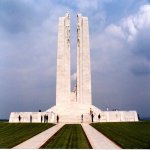"THE CHRIST OF THE TRENCHES
Upon entering the Chaptel room of the famous Monastery of Santa Maria da Vitória, located in Batalha (Portugal), the visitor is faced with a scene that arouses his curiosity: guarded by a guard of honor, an image of the crucified Christ – with the two severed legs, missing a hand and sporting a puncture in the center of the chest - presides over the Tomb of the Unknown Soldier. The appearance of the image should not, however, scare us, as it is a beautiful proof of the faith of the Portuguese soldiers who fought in the First World War. Let's know your story.
On April 9, 1918, a Lusitanian infantry division was stationed near the French town of Neuve-Chapelle, close to the border with Belgium. In the middle of the immense Flemish plain, on the way to the village of La Couture, the Portuguese soldiers could contemplate a lofty cross with an image of our Redeemer on the Cross.
That day, intense artillery fire set fire and reduced everything on the plain to rubble, leaving it strewn with the corpses of combatants, including 7,500 Portuguese expeditionaries. In the region of the battlefield, completely devastated by the bombardment, only the image of the crucified Christ was left standing. She stood on two stumps of legs, with her arms open as a sign of the welcome given to those who entrusted themselves to Him at the last hour.
The image was taken from the battlefield by surviving soldiers, anxious that this monument of faith and hope be venerated in a dignified place. Years later it was taken to Portugal, thus giving rise to the devotion of Cristo das Trencheiras. '"

Upon entering the Chaptel room of the famous Monastery of Santa Maria da Vitória, located in Batalha (Portugal), the visitor is faced with a scene that arouses his curiosity: guarded by a guard of honor, an image of the crucified Christ – with the two severed legs, missing a hand and sporting a puncture in the center of the chest - presides over the Tomb of the Unknown Soldier. The appearance of the image should not, however, scare us, as it is a beautiful proof of the faith of the Portuguese soldiers who fought in the First World War. Let's know your story.
On April 9, 1918, a Lusitanian infantry division was stationed near the French town of Neuve-Chapelle, close to the border with Belgium. In the middle of the immense Flemish plain, on the way to the village of La Couture, the Portuguese soldiers could contemplate a lofty cross with an image of our Redeemer on the Cross.
That day, intense artillery fire set fire and reduced everything on the plain to rubble, leaving it strewn with the corpses of combatants, including 7,500 Portuguese expeditionaries. In the region of the battlefield, completely devastated by the bombardment, only the image of the crucified Christ was left standing. She stood on two stumps of legs, with her arms open as a sign of the welcome given to those who entrusted themselves to Him at the last hour.
The image was taken from the battlefield by surviving soldiers, anxious that this monument of faith and hope be venerated in a dignified place. Years later it was taken to Portugal, thus giving rise to the devotion of Cristo das Trencheiras. '"

Last edited:


























































































